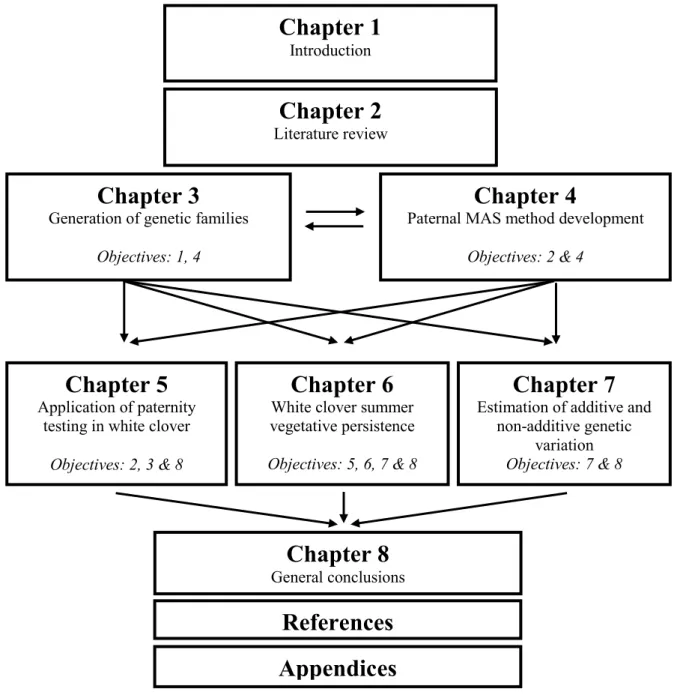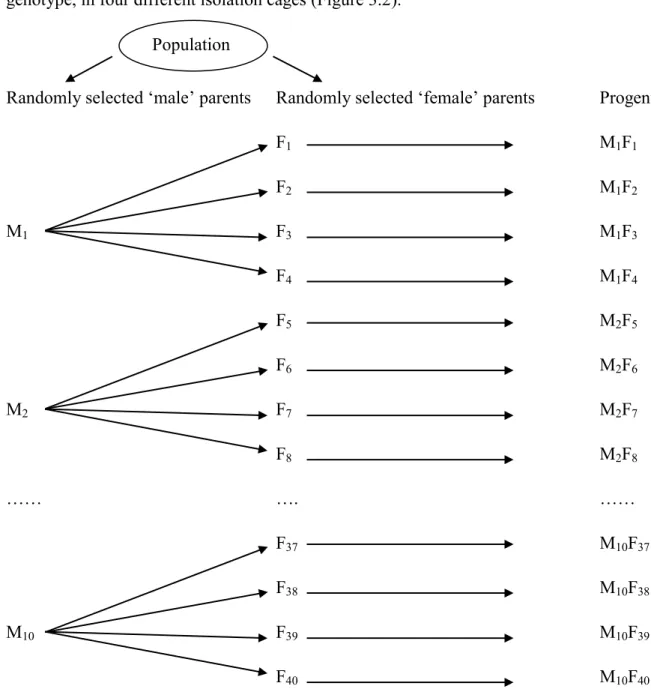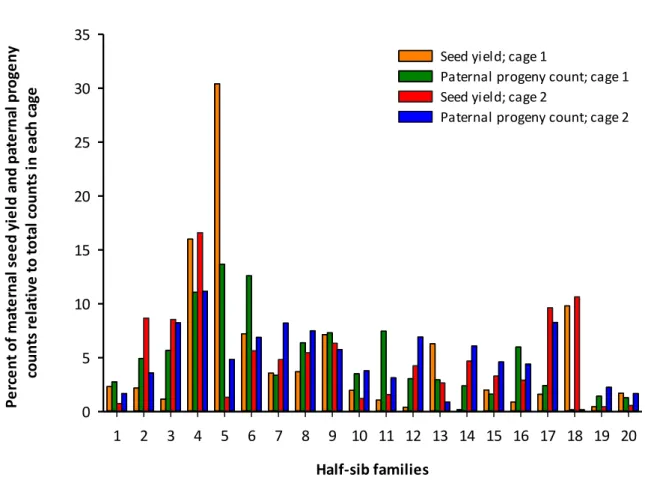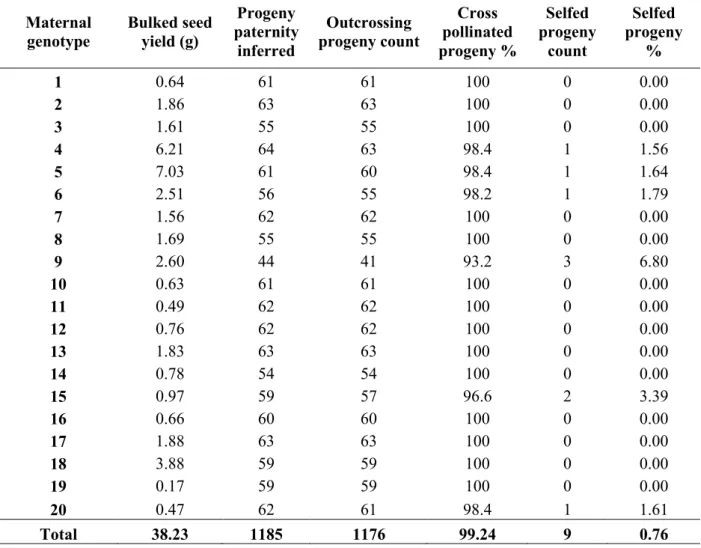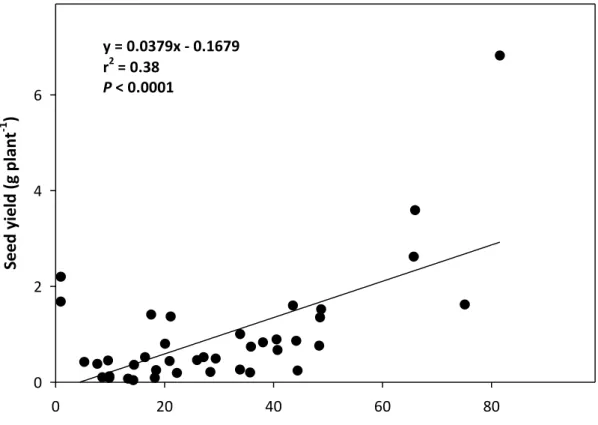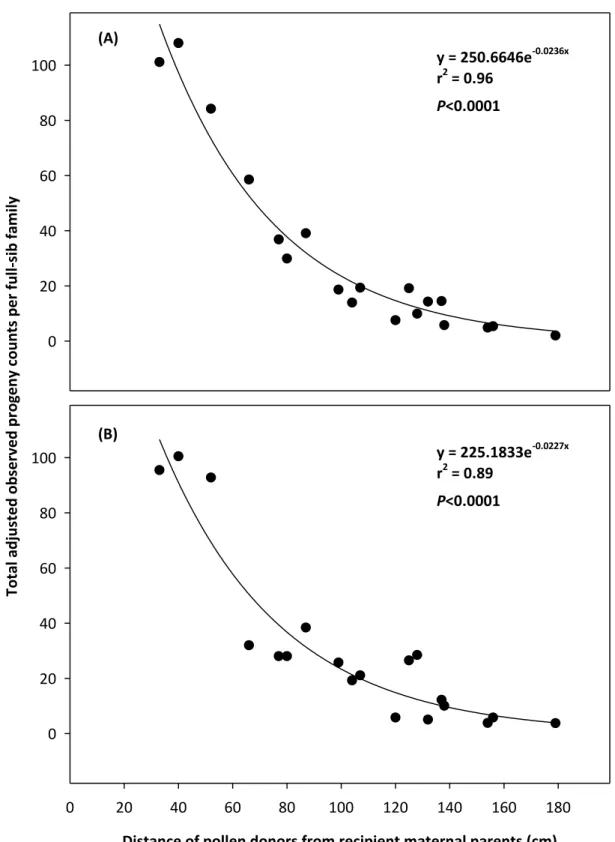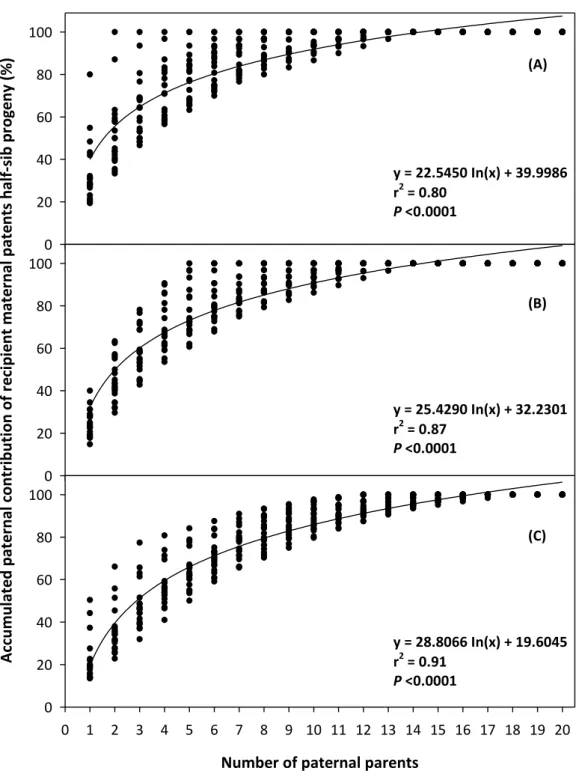In an experiment designed to generate half-sibling families for offspring evaluation, pollen dispersal in isolation cages using wild bumblebees (Bombus sp.) was monitored using simple sequence repeat molecular markers (SSR markers) . Low levels of paternal pollen dispersal at increasing distances from maternal recipients in isolation cages demonstrated the need for randomized multiclonal replication in white clover polycrosses, especially when used to generate half-sister families for progeny evaluation. The development and application of a new paternity testing method in white clover was successful in attributing paternity to known maternal half-sister offspring from a 20 parental polycross.
A panel of seven predefined SSR markers successfully determined the paternity of 92% of half-sibling offspring. Data collected from the offspring of paternal half-siblings determined by known maternal and molecular markers showed that their individual additive genetic variances were similar across a range of morphological traits and the two experimental sites. The differences in heritabilities calculated on the basis of half-breed family means and those on a single-plant basis support the rationale that breeders follow half-breed family selection methods for low heritability traits such as clover plant yield, whereas traits with moderate heritability on a single-plant basis plants such as leaf size support the use of phenotypic selection methods.
Key words: Trifolium repens, white clover, breeding methods, genetic disorders, paternity testing, half-sib families, full-sib families, spaced-planted, mini-plots, clover yield, persistence, moisture stress, pollination. AWF-HS+MFS – below-half-sib and within-sib molecular marker determines full-sib family selection.
Introduction
- Background
- Breeding progress in white clover
- Gaps in knowledge
- Objectives
- Thesis structure
A significant part of the current economic value of white clover is due to 75 years of plant breeding. Conventional plant breeding has consistently yielded improved performance of white clover in New Zealand pastoral systems (Woodfield and Easton, 2004). The gains achieved in white clover are the result of the accumulation of genes with better yield potential as well as the reduction of the effects of yield-limiting factors (Woodfield et al., 2001).
Advances in early white clover breeding programs were achieved by improving performance within existing ecotypes (Woodfield and Caradus, 1994). However, as with most types of forage crops, the agronomic improvement of white clover lags relatively behind many types of cereal crops. Vogel and Pedersen, 1993), but both empirical and theoretical studies specific to white clover are limited.
Generate genetic families from a random mating breeding population of white clover for evaluation in field trials. Key results are summarized in Chapter 8 and their overall implications for breeding strategies in white clover are discussed.
Literature review
Origin and systematics of white clover
White clover in New Zealand
- Agricultural importance
- Limitations of white clover
Morphology and persistence mechanisms of white clover
- Morphological phase I
- Morphological phase II
- Morphological phase III
- Reproduction
- Morphological features associated with water stress tolerance
- Physiological features associated with water stress tolerance
Plant genetic resources
- Germplasm associated with this thesis
Plant improvement through conventional breeding
- Forage plant breeding methods
- Population improvement
- Comparing breeding methods
- Types of cultivars
- Current breeding methodology in white clover
- Breeding progress in white clover
Plant improvement through molecular breeding
- Brief history and development of molecular markers
- Application of molecular markers in forage plant breeding
Estimating genetic parameters and genetic gain computations
- Expected gain computations
- Mating designs
- Genetic experiments in white clover
Summary
Generation of half-sib and full-sib families
Introduction
Materials and methods
- Experimental site
- Germplasm
- Mating designs and seed harvesting
- Seed preparation
- Paternity testing
- Statistical analyses
Results
- Polycross seed yields
- Maternal seed yield and pollen contribution
- Paternal outcrossing counts
- Pollen distribution
- Paternal contribution of half-sib families
- Pair-cross seed yields
Discussion
- Maternal seed yields and paternal progeny counts
- Pollen distribution
- Half-sib family paternal structure
Conclusions
Methodology development: paternity testing in white clover
Introduction
Materials and methods
Results
- DNA extractions
- Genotyping of polycross parents
- Selection of SSR markers for progeny paternity testing
- Progeny genotyping and paternity assignment
- Correlations
Discussion
- DNA extraction
- Panel of potential SSR markers
- Progeny genotyping and paternity assignment
- Cost of implementation
- Correlations
Conclusions
Application of paternity testing in white clover
Introduction
Materials and method
- Experimental site
- Trial site preparation
- Plant material
- Experimental design
- Trial management
- Measurements
- Paternity testing
- Statistical analyses
- Heritability
- Predicted genetic gain simulations
- Calculation of general combining ability (GCA)
Results
- Calibration curves
- Within season analyses
- Across season analysis
- Across environments and seasons analysis
- Comparison of maternal and paternal general combining ability (GCA)
- Simulated genetic gains using calculated genetic parameters
- Simulated genetic gains using putative genetic parameters
Discussion
- Calibration curves
- Within season analyses
- Across season analyses
- Across seasons and environments analyses
- Comparison of maternal and paternal GCAs
- Simulated genetic gains
- Trial design
Conclusions
Genetic variation in a breeding population for vegetative persistence and
Introduction
Materials and methods
- Experimental site
- Trial site preparation
- Plant material
- Experimental design
- Morphological measurements
- Physiological measurements
- Soil measurements
- Trial management
- Statistical analyses
Results
- Environmental measurements and plant water status
- Biochemistry
- Summer herbage yield
- Autumn recovery
- Multi seasonal analyses
- Multi seasonal and environmental analyses
- Pattern analysis
Discussion
- Fixed effects
- Variance components and heritabilities
- Pattern analysis
- Physiological analyses
Conclusions
Estimation of additive and non-additive genetic variation for traits associated with
Introduction
Materials and methods
- Statistical analyses
- Variance component analysis
Results
- Within seasons and environments
- Across seasons but within environments
- Across seasons and environments
Discussion
Conclusions
General conclusions
Results and their application to plant breeders
- Bi-parental and polycross pollination
- Adoption of novel breeding methods
- Effective trial designs
- White clover vegetative persistence
The key objective of this thesis was to investigate, using empirical and theoretical data, several breeding strategies that can be applied to white clover and that can increase the rate of genetic gain compared to current breeding methods. The literature shows that the predominant method of breeding white clover is phenotypic recurrent selection (Williams, 1987; Woodfield and Caradus, 1994), although in some situations trial testing of progeny of a certain description is also used (Woodfield et al., 2003). ). Given this, the lack of available information on the actual details of pollination in isolation cages for white clover seems somewhat surprising.
Similar to alfalfa (Riday et al., 2013) and previous reports on white clover (Michaelson-Yeates et al., 1997), this leptokurtic pollen distribution in white clover isolation cages illustrates the importance of clonal replication or other methods to increase the chance on random mating. The results of this thesis suggest that clonal replication, in combination with higher seed yields and more inflorescences per plant, is likely to alleviate random mating problems in white clover isolations. The lack of self-fertilization in both the polycross and bi-parental offspring should give breeders confidence that relatively little inbreeding occurs in white clover isolation cages and contradicts the findings in Lucerne (Riday et al., 2013).
Similarly, data generated from quantitative genetic experiments described in this thesis could be used to interpret the rationale for pursuing different breeding methods in white clover. For this reason, and the difficulty of maintaining individuality as discussed in Chapter 5, the use of paternity testing in white clover should be modified accordingly to effectively transition into field breeding programs. To date, the lack of available literature on the genetic parameters of random mating white clover populations evaluated in multiple target environments has limited the ability to simulate predictive gain models with realistic data (Jahufer et al., 2002).
Crude estimates of additive and non-additive variances for most traits in white clover generally agree with breeding methods that focus largely on additive genetic variation in white clover. Adoption of the miniplot methodology used in this thesis should also be reconsidered in any future studies on quantitative genetics of white clover. Transplanted miniplots have been routinely used in white clover breeding programs because of their minimal area requirement, ability to evaluate large numbers of entries, reliable establishment, and minimal soil disturbance, resulting in reduced movement of buried seed to the soil surface.
It appears from the data and observations presented in this study, combined with previous studies, that a major contributor to white clover persistence is regulated by a moisture stress × heat × animal grazing × genotype interaction. The data also demonstrated a decrease in white clover persistence regardless of water stress and highlight the possibility of a loss in population performance per se due to the transition of white clover to its vegetative morphological phase as hypothesized by Brock and Caradus (1996). Physiological combined with morphological data showed that the white clover population studied in this study was poorly adapted to soils with low water-holding capacity, such as those at Ashley Dene (dryland), and this supports results presented by Mills and Moot (2010), where use of alternative species such as subclover and alfalfa is better suited for summer productivity in such soils.
Future work
Investigating the role that tiller removal has on the long-term persistence of white clover in both irrigated and summer moisture-deficient environments. 1999) Heritability of, and genetic correlations between, feed and seed yield traits in Ladino white clover. The role of stolons and seedlings in the persistence and production of white clover (Trifolium repens L. cv.
The evaluation of individual plants of white clover for yield potential in association with bluegrass. White clover: New Zealand's competitive advantage. 2007) Grasslands Trophy - a new white clover (Trifolium repens L.) cultivar with tolerance to summer moisture stress. 1988) Evaluation of white clover cultivars bred in New Zealand under rotational grazing and stocking with sheep.
Proceedings of the New Zealand Grassland Association Grazing management of white clover in mixed pastures. 1994) Influence of the stolon/soil surface and plant interface. morphology on the survival of white clover in severe drought. Proceedings of the New Zealand Grassland Association Effect of grazing and drought management on white clover population performance and genotypic frequency.
Joint Symposium, Lincoln University, New Zealand Effect of white clover cultivar on plant morphology during mixed pasture establishment among grazing sheep. New Zealand Journal of Agricultural Research Variability of stolon characteristics and response to shade in two cultivars of white clover (Trifolium Repens L.). New Zealand Journal of Agricultural Research Selection for and heritability of stolon traits in two cultivars of white clover. 1996) Overview and vision for white clover.
White clover: New Zealand's competitive advantage. evaluation of white clover cultivars in plant and small-species mixed-plot trials. New Zealand Journal of Agricultural Research breeding and description of 'Grasslands Sustain', a cultivar of medium large leaf white clover (Trifolium repens L). New Zealand Journal of Agricultural Research Inheritance of phosphorus response in white clover (trifolium- repens l).
Observed outcross progeny counts per full-sib family
Relationship between seed yield and the number of harvested inflorescences
Relationship between the number of paternal parents
Relationship between maternal seed yield and paternal parents
Correlation between paternity assignment rates (%) and average LOD scores
Correlation between average maternal half-sib family LOD scores
Chemical characteristics of the soil at the AgResearch and Ashley Dene sites
Physical characteristics of soil profiles at the AgResearch and Ashley Dene trial sites
AgResearch polycross nursery layout
Ashley Dene polycross nursery layout
Chemical characteristics of the soil at the irrigated field experiment
Chemical characteristics of the soil at the dryland field experiment
Volumetric soil water content of the 0-115cm soil profile at the irrigated site
Volumetric soil water content of the 0-115cm soil profile at the dryland site
Mean 13 C discrimination for the irrigated and dryland sites
Correlation between carbon 13 C discrimination and leaf width
P-values obtained from analyses of variances for phenolic compounds
Mean quercetin glycoside and kaempferol glycoside accumulation in the leaves
Mean total flavonols, quercetin glycosides, kaempferol glycosides, and ratios
Pearson correlations among flavonol components
Pearson correlations among flavonol components across both sites and years
